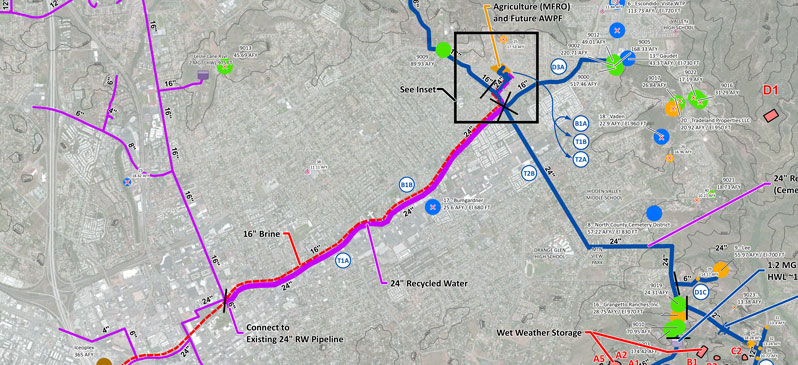
Started at the HARRF in the Fall of 1998, Phase I Construction is a major rehabilitation of existing facilities and will improve secondary treatment efficiency. Phase II Construction, completed in 2001, adds tertiary treatment capability to create high quality water production for reuse as irrigation on local golf courses, parks, school grounds, green belts, roadway medians, open spaces and industrial use. Phase III Construction, currently being designed, will include a replacement administration building and a rebuild of the influent pump station and the primary treatment building.
Hale Avenue Resource Recovery Facility (HARRF) includes roughly 360 miles of pipelines and 14 pumping station which serve as the sanitary collection system backbone to direct this community’s domestic & industrial wastewater to it’s treatment plant, the HARFF.
View the Early Phase Overview for the Reuse Program
Overview Map
The MFRO facility will receive HARRF Title 22 recycled water. HARRF has a permitted wastewater treatment capacity of 18 mgd and 9 mgd tertiary capacity. The plant uses conventional activated sludge for secondary treatment and includes the following major processes: influent pump station, bars screens, grit chambers, primary clarifiers; aeration basins, secondary clarifiers; tertiary filters and chorine disinfection. Historical water quality of HARRF recycled water is provided in Table 2-1 attached.
The Feasibility Study discussed water quality requirements for the City’s agriculture producers with a key focus on avocado production which is one of the most important crops grown in Escondido. The limits of various water quality parameters that can diminish avocado crop productivity are provided in Table 2-2. This information was obtained based on meetings with members of the Escondido Growers of Agriculture Preservation (EGAP) as well as published information in the literature. Based on discussions with EGAP, it is desired to reduce the chloride concentration to 80 mg/L to prevent leaf burn, root rot and the need for excessive flushing however chloride concentrations up to 100 mg/L can be tolerated. It should be noted historical water quality provided by the City shows the average chloride concentration in raw source water supplies varies as follows: Lake Henshaw = 39 mg/L; Dixon Lake = 80 mg/L; and imported water via SDCWA = 81 mg/L. The average chloride concentration of the treated water from EVWTP is 75 mg/L.
Meeting MintuesThe California Environmental Quality Act: exemption: recycled water pipelines.
Read More
